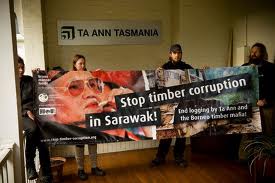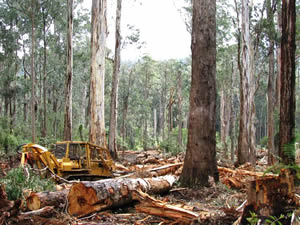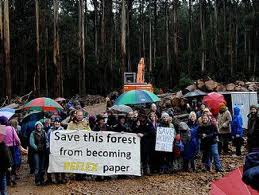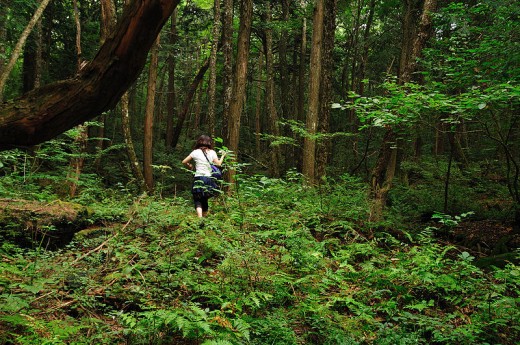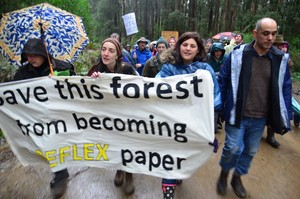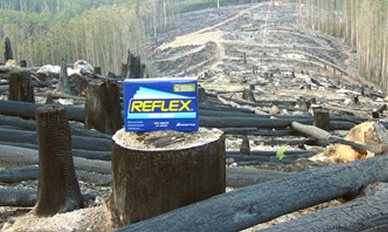Ta Ann greenwashing and destroying Tasmania
Sunday, October 23rd, 2011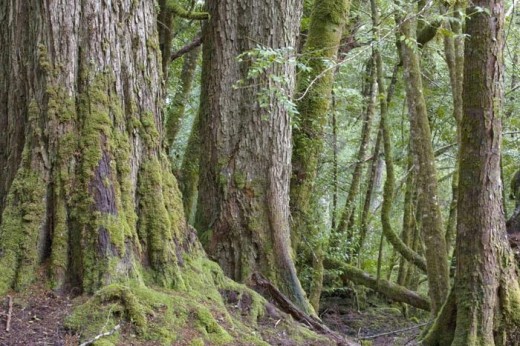 It starts with a natural forest that due to ‘humanity’ has become rare, threatened and endangered
It starts with a natural forest that due to ‘humanity’ has become rare, threatened and endangered~ Tasmania’s ancient wild Weld Forest
.
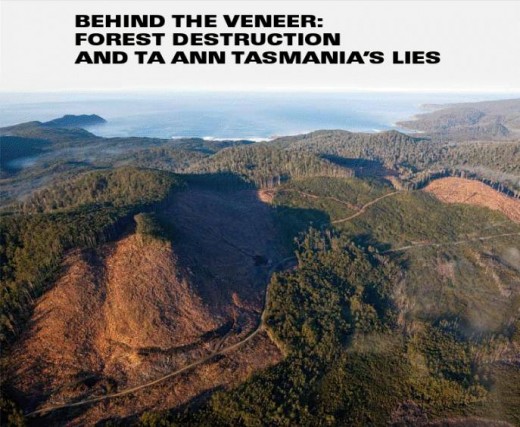 Tasmanian Old Growth Eucalypt Forests destroyed by Forestry Tasmania and onsold to Ta Ann
http://www.huon.org/
Tasmanian Old Growth Eucalypt Forests destroyed by Forestry Tasmania and onsold to Ta Ann
http://www.huon.org/
.
Malaysian industrial logger ‘Ta Ann Tasmania‘ (Ta Ann) has overtaken the monolithic Gunns Ltd as the biggest baddest logger of Tasmanian native Eucalypt forests and is busy enticing new overseas markets to flog Tasmanian Eucalypt timber.
Ta Ann claims that it exports rotary peeled veneer manufactured only from regrowth and plantation Eucalypt logs supplied by Forestry Tasmania, boasting its logging operations and timber products as environmentally sustainable.
But the reality is that Ta Ann is sourcing timber from Tasmanian old growth forests, from world heritage value and high conservation value forests.
As many Tasmanians are well familiar, Tasmanian Government impune Forestry Tasmania has an internal cultural penchant do anything to log and flog Tasmanian forests to perpetuate its own survival. Tasmanian legislation allows it to log, slaughter and rule with impunity like a forestry Mugabi, Gaddafi or Pol Pot. Forestry Tasmania is accountable only unto itself.
In 2008, AusIndustry even awarded Ta Ann winner of the Emerging Exporter Award for building its new flooring ply market in Japan flogging Tasmanian Eucalypt forest timber, all on the presumption that Ta Ann’s chain-of-custody certification was assured and legitimate. But was it and is it?
Tasmania’s big business biased history has shown that the promise of lots of local jobs by alluring big business causes dizzy evangelism by naive high school politicians, which then abandon ethics and Tasmanian community pride for the promise of the big buck. Traditional Tasmanian timber asset and its passionate local craftsmanship have been repeatedly betrayed by short-termism party politicians to cheap asian woodchipping mentality.
The latest Tas-rapist is ‘Ta Ann’ owned by exploitative unscrupulous Malaysian logger mogul Abdul Hamed Sepawi. He treats Sarawak indigenous locals like scum, so why would he feel any different to Tasmanians? – be it old growth forests, timber workers, their families, Tasmania’s economy or rural society?
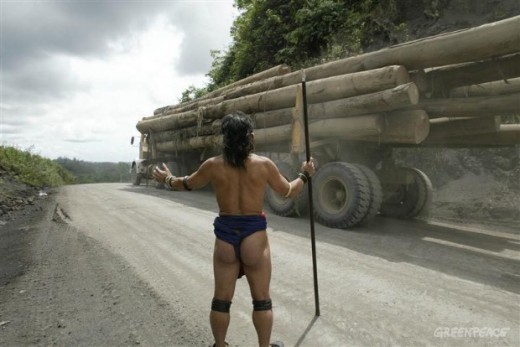 Indigenous Sarawak of Borneo seeing their forests go to Abdul’s Malaysian industrial loggers
Indigenous Sarawak of Borneo seeing their forests go to Abdul’s Malaysian industrial loggers
.
Abdul is into logging Tasmanian forests for his own empire. Those Tasmanians participating in Ta Ann operations are not only feeding an asian mogul’s personal wealth, they are selling Tasmania’s unique forest assets, accepting pittance pay, and watching the asian mogul smile.
 Malaysian’s Logger Mogul… Greedy Abdul
Malaysian’s Logger Mogul… Greedy Abdul
.
One day Tasmanians working in forestry will acknowledge that the radial feral greenies are not their adversaries but indeed more Tasmanian patriotic than their asian logging employers and Tasmanian Labor’s soul-selling politicians.
It is time Tasmania’s skilled woodcraftsmen had their say over the unethical, self-perpetuating and uncontrolled smiling eco-rapists of Forestry Tasmania and its exploitative asian logging moguls.
 Smiles of the asian woodchipper and Tasmanian soul seller
Smiles of the asian woodchipper and Tasmanian soul seller.
Based on the claim of ‘forestry certification’ legitimacy, Ta Ann has been locally encourage to build its second timber mill at rural Smithton in north-west Tasmania to supply emerging flooring ply/veneer markets in Malaysia, Japan and China.
.
[Source: ^http://www.exportawards.gov.au/Resources/Case-Studies/Ta-Ann-Tasmania/default.aspx]
.
.
However, Tasmania’s forest campaigners Jenny Weber and Peg Putt have exposed Ta Ann Tasmania’s timber source to some of their customers in Japan, in alliance with Japanese forest campaign organisation JATAN. Meetings have been held with flooring manufacturer Panasonic Electric Works and Japan’s largest house building companies, Sekisui House and Daiwa House.
Huon Valley Environment Centre’s Jenny Weber with International Forests and Climate campaigner and former leader of the Tasmanian Greens Peg Putt, also met with Japanese and international NGO’s who are focused on forest protection, whilst visiting Japan. A media conference was held in Tokyo.
‘Huon Valley Environment Centre released a report in October that exposes Ta Ann has sourced timber in Tasmania from world heritage value, old growth and high conservation value forests. Ta Ann and their Japanese partner claim that their timber from Tasmania is only sourced from plantations and regrowth forests. Our message to the customers of Ta Ann was that the source of the company’s timber has been misrepresented,’ Huon Valley Environment Centre’s Jenny Weber said.
Companies such as Panasonic Electric Works, Sekisui House and Daiwa House have set goals to procure environmentally friendly timber, whose production does not contribute to large scale logging, nor harm biodiversity or the climate.
.
‘Informing these companies about the ecologically destructive logging practices in Tasmania and the reality that Ta Ann is sourcing timber from old growth, world heritage value and high conservation value forests was a shock to the companies who believe the timber source is environmentally friendly, who had been misled and in some cases thought that Ta Ann’s veneer was plantation grown,’ Jenny Weber said.
‘Even worse Ta Ann is standing in the way of full protection of 572,000 hectares identified for reservation in the Intergovernmental Agreement on Tasmania’s forests, and this company is implicated in environmental and human rights abuses in Sarawak. It was important to inform Japanese customers of the potential reputational damage involved in their relationship with Ta Ann,’ Peg Putt said.
‘Ta Ann in Tasmania is now going to be a focus of our campaign, following our successful collaboration with Australia NGO’s over the woodchip trade between Tasmania and Japan. I have visited forests in Tasmania that have been logged for Ta Ann in Tasmania, and witnessed the forest destruction on many occasions,’ said Akira Harada of JATAN.
.
[Source: ‘Tasmania’s forest campaign goes global – Ta Ann Exposed to Customers in Japan, 20111015, Huon Valley Environment Centre, Tasmania].
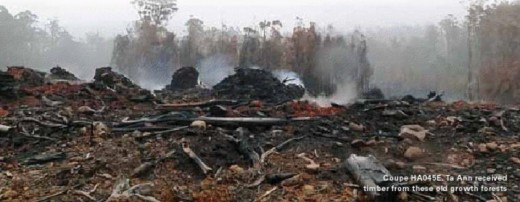 Forestry Tasmania Coupe HA045E was Eucalypt old growth
Ta Ann received timber from this coupe, which therefore annuls its ‘Sustainable Timber’ Certification
Forestry Tasmania Coupe HA045E was Eucalypt old growth
Ta Ann received timber from this coupe, which therefore annuls its ‘Sustainable Timber’ Certification
.
Read the Huon Valley Environment Centre’s 2011 Report: ^http://bit.ly/mRlUbs
.
.
The Huon Valley Environment Centre’s 2011 Report needs to be investigated by the Forestry Stewardship Council (FSC) Australia with the support of the Australian Government, because the report calls into question the credibility of Australia’s timber exports having a certification chain-of-custody. If the Huon Valley Environment Centre’s report is true, and there is no doubt that it isn’t, then Ta Ann’s business model is relying upon a fraud, meaning its entire market risks unraveling, along with the 120 or so Tasmanian timber jobs it supposedly supports.
FSC certification and labeling is supposed to guarantee to end consumers that such timber products and materials have been harvested, processed and manufactured in a sustainable fashion – complying with sound forest management standards and principals. The FSC label is the gold standard in forest management and sustainable wood products.
FSC products are denoted by the FSC label. The right to use this label on a product means that a company must comply with all of the FSC requirements for management and operations. The requirements set forth by the FSC are based on 10 principles and 56 criteria.
.
The principles that guide FSC certification are as follows:
.
Principle 1. Compliance with all applicable laws and international treaties
Principle 2. Demonstrated and uncontested, clearly defined, long–term land tenure and use rights
Principle 3. Recognition and respect of indigenous peoples’ rights
Principle 4. Maintenance or enhancement of long-term social and economic well-being of forest workers and local communities and respect of worker’s rights in compliance with International Labour Organisation (ILO) conventions
Principle 5. Equitable use and sharing of benefits derived from the forest
Principle 6. Reduction of environmental impact of logging activities and maintenance of the ecological functions and integrity of the forest
Principle 7. Appropriate and continuously updated management plan
Principle 8. Appropriate monitoring and assessment activities to assess the condition of the forest, management activities and their social and environmental impacts
Principle 9. Maintenance of High Conservation Value Forests (HCVFs) defined as environmental and social values that are considered to be of outstanding significance or critical importance
Principle 10. In addition to compliance with all of the above, plantations must contribute to reduce the pressures on and promote the restoration and conservation of natural forests.
.
FSC Chain of Custody Certification
Chain of custody (CoC) certification allows manufacturers who process and trade in timber and other non-timber forest materials to trace and account for the FSC certified wood in their products. Companies with FSC CoC certification can label products with the FSC label if they comply with the standards.
.
[Source: ^http://www.green3dhome.com/GoGreen/FSCCertificationandLabeling.aspx] Gardening guru Peter Cundall prepared to be arrested for Tasmanian Principle
to defend Tasmania’s Forests and Tasmania’s democracy protesting against a pulp mill.
(19 Nov 2009)
Gardening guru Peter Cundall prepared to be arrested for Tasmanian Principle
to defend Tasmania’s Forests and Tasmania’s democracy protesting against a pulp mill.
(19 Nov 2009)
.
Watch on You Tube: http://www.youtube.com/watch?v=OVRhUtJBjxc
.
.
If the Huon Valley Environment Centre’s report is true then it would mean that Forestry Tasmania is complicit in Sustainable Timber Certification fraud and it would make Australia’s Emerging Exporter Award a joke.
Australia’s Emerging Exporter Award is a national Australian programme jointly run by The Australian Trade Commission (Austrade) and the Australian Chamber of Commerce and Industry (ACCI), which recognises and honours exporters who have achieved sustainable export growth through innovation and commitment. It celebrates and highlights the valuable contribution that exporters make to Australia’s economy, and encourages other companies to engage in international business. The programme objectives even states that it is to ‘promote Australia’s leading exporters to the same status and public recognition as sporting and entertainment heroes’. So Ta Ann is up there with Donald Bradman?
But Ta Ann Tasmania is a Malaysian multinational corporation and all profit go to overseas to its Malaysian logging mogul, Abdul Hamed Sepawi. Ta Ann, has not only been destroying rainforests in Sarawak but has been invited to pillage Tasmanian old growth Eucalypt forests by yours truly, Forestry Tasmania. So how can this venture be beneficial for Australia except for the so-called ‘export revenue’ making government export performance look good on paper?
.
‘Ta Ann is the biggest hardwood timber company in the world in terms of market capitalization. It has been able to achieve this through its close ties with the corrupt Chief Minister of Sarawak, Abdul Taib, whose vast wealth and power has been amassed through the strategic distribution of timber concessions. Taib is also finance minister and planning and resource management minister.
Earlier this month (March 2011) , the European NGO “Bruno Manser Fonds” (founded by the Swiss activist of Bruno Manser who lived in the jungle with the Penan from 1984 to 1990 and shared their struggle before mysteriously disappearing in Sarawak in 2000) released a blacklist of 49 companies in 8 countries (10 of them based in Australia) and is urging anti-corruption and anti-money laundering authorities in these countries to investigate any improprieties.
This is being reported in the Malaysian press as follows: “According to Malaysia’s Democratic Action Party (DAP), Taib has failed to account for a staggering 4.8 billion Malaysian ringgits (1.58 billion US dollars) of Sarawak state funds over the past three years alone. In 2007, the Tokyo tax authorities uncovered a massive corruption scheme that involved the payment of kickbacks to the Taib family. In return, nine Japanese shipping companies had received export licences to carry logs to Japan, Sarawak’s largest timber export market.” . And so on.
Ta Ann Holding’s chairman is Taib’s cousin, Abdul Hamed Sepawi. In 2008, Forbes listed Sepawi as the 30th richest man in Malaysia. Ta Ann holds 408,366 hectares of timber concessions, including the Raplex and Pasin timber concessions, which were previously controlled by Taib. They are also heavily engaged in the establishment of industrial tree plantations and oil palm plantations on Native Customary Land In Malaysia.
As Tasmania’s main newspaper, The Mercury reported on Sat Nov 8 2008 p11: “Ta Ann was lured to Tasmania by the cheap timber price offered by Forestry Tasmania. Ta Ann chairman Datuk Hamed Sepawi told Tasmanian media in 2006 that hardwood from this state was cheaper than wood from Malaysian and Indonesian forests…. Ta Ann’s deal with the State Government locked in the price it would pay for the timber at the 2006 level for the next 15 years.”
Ta Ann has a wood supply contract for 265,000 m3 a year. It is estimated that Ta Ann is paying approximately US$50 per cubic meter for these logs at a fixed price and then selling the product for US$387 per cubic meter.’
.
[Source: The Southern Forests Convergence: Conservation in Tasmania’ by John Seed, <Living Green Magazine, ^http://www.livinggreenmag.com/archives/climate_nature/southern_forests.html].
.
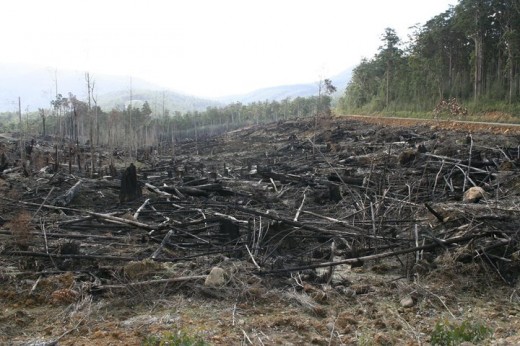
The Huon Valley Environment Centre and Still Wild Still Threatened are Tasmanian grassroots conservation organisations committed to ending logging in Tasmania’s old-growth forests.
.
“Our organisations are committed to continuing the campaign to call for the immediate protection of all native forests in Tasmania, including a moratorium on the globally significant high-conservation-value forests and a swift transition out of native forest logging in Tasmania.” ~ Jenny Weber
.
Three protests were held around Hobart yesterday (26th March 2011) as part of the 10-day vigil by the Huon Valley Environment Centre and Still Wild Still Threatened groups to stop logging in old-growth forests.
Four protesters were arrested outside the Ta Ann Hobart office yesterday morning during a sit-in demonstration against Ta Ann’s alleged illegal activity in Sarawak.
.
[Source: ‘Police anger over protest‘, by Brian Ward, Hobart Mercury, 20110326, ^http://www.themercury.com.au/article/2011/03/26/217591_tasmania-news.html].
.
Tasmanian protests ongoing to save Tasmanian Forests
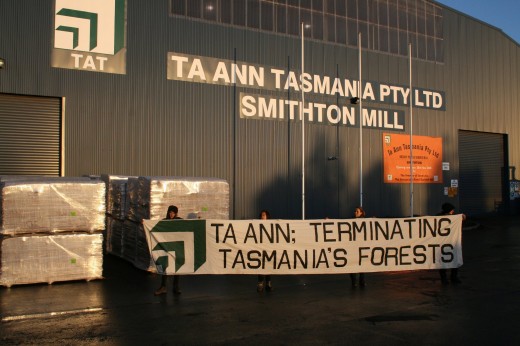 Ta Ann’s mill at Smithton
Ta Ann’s mill at Smithton
.
This morning, grassroots forest groups the Huon Valley Environment Centre, Still Wild Still Threatened and Code Green have taken action at the Ta Ann veneer mill in Smithton. Twelve conservationists entered the site at 6am and two activists are locked on to machinery, halting operations. The protestors are displaying a banner reading ‘Ta Ann terminating Tasmanian forests‘.
 Ta Ann’s mill carved into the forests in Tasmania’s Huon Valley
Ta Ann’s mill carved into the forests in Tasmania’s Huon Valley.
This action takes place in response to Ta Ann’s role in blocking a solution for Tasmania’s forests. Grassroots environment groups are raising concerns over yesterday’s Intergovernmental Agreement on forest.
“We are aware of Ta Ann’s shocking environmental and human rights practices in Sarawak and we are raising the question to the State and Federal government – why is this exploitative Malaysian company allowed to continue destroying our forests and threaten Tasmania’s chance to move forward to a sustainable industry?” said Code Green spokesperson, Joanna Pinkiewicz.
.
“Yesterday’s agreement guarantees Ta Ann’s contract until at least 2027.
This Malaysian logging giant has a deplorable record in (Indonesia’s) Sarawak and are now entrenching large scale clear felling of native forests in Tasmania”
.
~ Huon Valley Environment Centre spokesperson Jenny Weber.
.
“The intergovernmental Agreement leaves open over 140,000 hectares of identified high conservation value forest to potential logging. Contracts with companies such as Ta Ann could jeopardise the future protection of high conservation value forests, with further reductions to the reserve area still on the table” said Still Wild Still Threatened spokesperson Miranda Gibson.
“While we look forward to seeing high conservation value forests protected, the real hurdles are yet to come. This agreement is a first step that has not yet guaranteed formal protection of these forests, that is long overdue” said Ms Weber.
.
[Source: ‘Ta Ann Mill Shut Down‘, 201108122, ^http://hornbillunleashed.wordpress.com/2011/08/12/22368/].
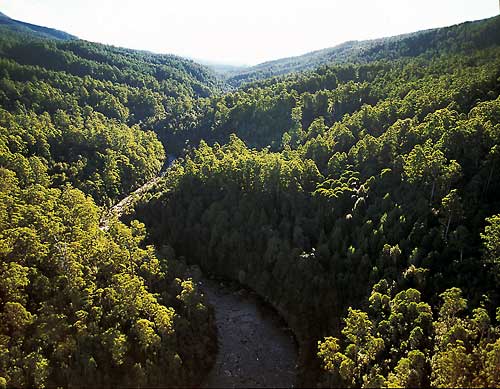 Tasmania’s Weld Valley – being logged by Ta Ann
(Photo by Rob Blakers)
http://www.water-sos.org/rob-blakers4.html
Tasmania’s Weld Valley – being logged by Ta Ann
(Photo by Rob Blakers)
http://www.water-sos.org/rob-blakers4.html
.
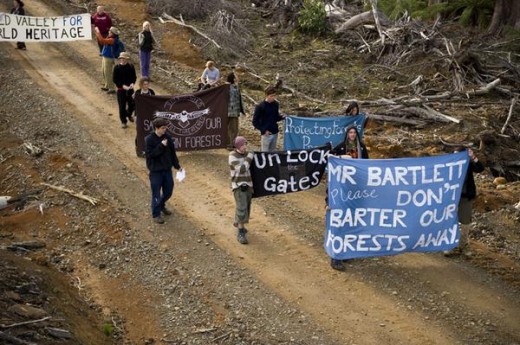 Human Plea
Human Plea



